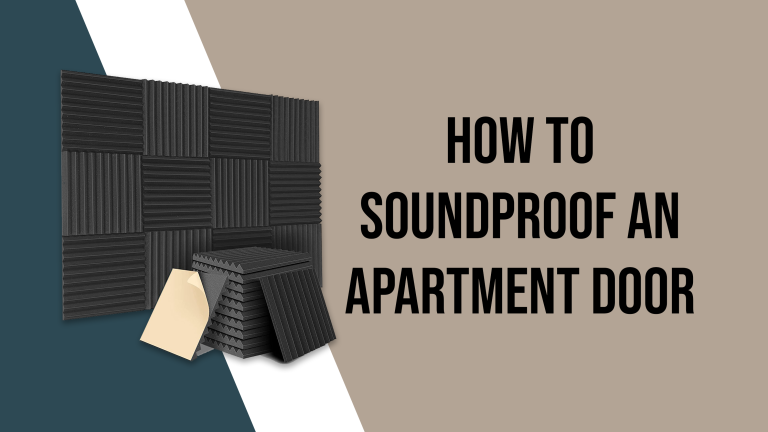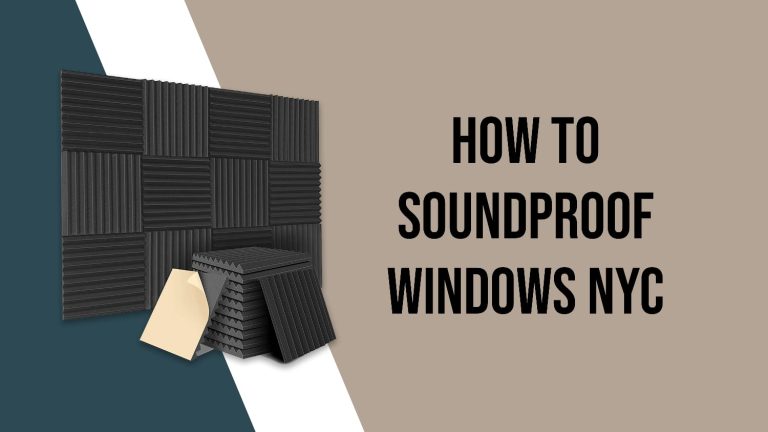11 Ways to Soundproof a Window [DIY]
Tired of the incessant noise coming through your windows? Fear not! There are various DIY techniques you can use to soundproof your windows and effectively block out the noise from street traffic, noisy neighbors, and more.
In this article, we’ll discuss 11 methods you can use to soundproof windows without replacing them.
11 Ways to Soundproof a Window [DIY]
If you’ve ever wondered about how can I soundproof my windows, we’ve some easy solutions for you. From DIY solutions to professional-grade soundproofing, you’ll find all the possible methods of soundproofing windows in this section.
Acoustic Sealants
One of the simplest ways to soundproof windows is by using acoustic sealants. Apply these around the borders of your windows to seal any gaps and prevent sound from entering your home. Make sure to use a high-quality acoustic sealant, as conventional caulk may harden and crack over time.
Window Foam
Window foam, also known as a window plug, is an affordable DIY solution for window soundproofing. Attach an acoustic foam mat to make windows soundproof and reduce the noise coming in. Keep in mind that while window foam can help dampen sound waves, it may also block out light.
Interior Acrylic or Glass Sheet
For a more effective DIY soundproofing method, consider attaching an acrylic or glass sheet to the inside of your existing window. Install a metal frame on your window and use magnets to secure the acrylic sheet or glass. This method can be quite useful for minor noise problems, but may not be as effective against loud, deep sounds.
External Storm Windows
Installing storm windows on the exterior of your home is another option for DIY window soundproofing. The additional layer of glass can help dampen sound while also improving your windows’ insulation. The effectiveness of storm windows will depend on the glass thickness, the frame’s seal, and the air trapped within the window.
Noise Reducing Curtains
Noise-reducing curtains, also known as thermal curtains, can help with both acoustics and insulation. However, they may not be the most effective or practical solution for soundproofing, as they can create condensation issues and mold growth. If you’re considering this option, weigh the pros and cons before making a decision.
Noise Reducing Blinds or Shutters
Installing blinds or shutters can help reduce noise by adding more material between the source of the noise and your home’s interior. Special honeycomb cell shades, timber window shutters, and insulating blinds are some of the best options for soundproofing. And if curtains aren’t doing the job for you, read on to find more methods on how to soundproof windows DIY.
Soundproofing with Furniture
Placing furniture near your windows can help enhance the noise-reducing benefits of your other window treatments. Thick, heavy rugs, couches, or chairs can capture some of the sound waves and reduce the impact of outside noise.
Self-Adhesive Foam Seal Strip
Applying self-adhesive foam tape around your window frame is an easy and cost-effective DIY solution for soundproofing. High-density foam tape can help reduce noise from outside, but be cautious when removing it to avoid damaging the window frame or paint.
Mass Loaded Vinyl Sound Barrier
Mass Loaded Vinyl (MLV) is a versatile soundproofing material that can be used for a variety of applications, including window soundproofing. Made from PVC and vinyl combined with heavy materials like barium sulfate or calcium carbonate, MLV is designed to dampen impact sounds and reduce vibrational noise.
To use MLV for window soundproofing, hang it over the window like you would with heavy curtains. While it may not be the most visually appealing option, MLV can be painted to match your interior decor. Keep in mind that MLV is most effective for dampening impact sounds rather than airborne noise, like traffic.
Acoustic Panels
Acoustic panels can also be an effective DIY solution for soundproofing windows. These panels are made from dense, sound-absorbing materials that can help reduce outside noise. Simply attach the panels to your window frame or create a removable window plug to fit the size of your window.
Remember that using acoustic panels will block natural light, so consider this option for rooms where light is not a priority or if you plan to use them only during specific times.
Soundproof Window Plugs
Custom-made soundproof window plugs can be an effective DIY solution for noise reduction. These plugs are typically made from a combination of materials, such as acoustic foam and MLV, and are designed to fit snugly into your window frame.
When not in use, window plugs can be easily removed and stored, making them a convenient and temporary solution for soundproofing windows. Keep in mind that this option will block natural light while in use.
Thermal Insulation Boards
Thermal insulation boards can serve as an alternative to window plugs for soundproofing windows. Made from dense foam or other insulating materials, these boards can be cut to fit your window frame and installed either temporarily or permanently. They not only help with noise reduction but also improve your home’s energy efficiency.
Keep in mind that using thermal insulation boards will block natural light and may not be the most visually appealing option.
Exterior Noise Barriers
An exterior noise barrier can help reduce outside noise before it reaches your windows. Consider planting dense hedges or installing hardscape features like stone walls or waterfalls to absorb some of the sound waves. This option allows you to maintain the aesthetics of your home while providing noise reduction benefits.
Factors to Consider When Soundproofing Windows
Before choosing to DIY soundproof windows, consider the following factors:
- The type of noise: Is it high or low pitch? How loud is the noise? Is it constant or intermittent?
- The effectiveness of the solution: The best way to soundproof windows is the one that suits your needs the best. Weigh the pros and cons of each DIY method and consider whether the noise reduction benefits outweigh the potential drawbacks.
- Your budget: Evaluate the cost of each solution and determine which one fits your budget while still providing the desired noise reduction.
Professional Soundproofing vs. DIY Solutions
While DIY soundproofing methods can be effective, they may not provide the same level of noise reduction as professional solutions. Double glazing with laminated or acoustic-grade glass is a more effective and long-lasting solution for reducing outside noise. Retrofit double glazing can be a cost-effective alternative, providing similar noise reduction benefits while retaining the original charm of your existing windows.
How to Soundproof Windows Without Replacing Them?
If you don’t want to replace your windows or do any hard work, there are some simple DIY methods you can use to soundproof windows without replacing them. Here’s how to make windows quieter.
- Use soundproof curtains. By hanging thick curtains over your windows, you can reduce the noise coming in and going out of your windows. It’s an easy solution that requires next to no work.
- Install acoustic panels: Acoustic panels made out of foam are great for soundproofing. They can easily absorb sound waves and reduce loud noises to mere muffles. These might block the light as well.
How Can I Make my Windows Soundproof?
You can make your windows soundproof by using various techniques. Here are some of the most effective ways to make your windows soundproof:
- Repair any gaps or cracks in your windows.
- Use window inserts or weather-stripping around your window frames/
- Consider replacing your current windows with double or triple-pane windows.
- Use acoustic glass.
- Use soundproof curtains.
How Can You Soundproof A Window?
There are plenty of ways to soundproof windows if you want to do it yourself. Here are some of the easiest DIY solutions to soundproof windows.
- Install window inserts. An easy and cost-effective way of soundproofing windows is to add window inserts. Different types of window inserts are available to use. To get the best noise reduction, install window inserts that block the type of noise you’re facing.
- Use weather-stripping. Install weather stripping in and around the window frames. These strips seal the tiny gaps and stop sound waves from entering through the window.
And that’s how to make windows quieter. There are plenty more methods to soundproof windows, but you’ll have to call in a professional for those methods including reinforcing them or replacing them with double or triple pan windows.
Conclusion
Soundproofing windows can be accomplished through various DIY methods, from using weather-stripping and sealants to installing MLV or acoustic panels. However, it’s essential to consider the type of noise you’re dealing with, the effectiveness of each solution, and your budget before making a decision. In some cases, investing in professional soundproofing methods, such as double glazing, may offer more significant noise reduction benefits in the long run.
FAQ
How do I determine the most suitable soundproofing method for my windows?
Consider the type of noise, its frequency, and intensity, as well as your budget and aesthetic preferences. You may need to try different methods or combine several approaches to achieve the desired level of noise reduction. Consulting a soundproofing professional can also help you determine the most effective solution for your specific situation.
Will soundproofing my windows completely eliminate outside noise?
While soundproofing can significantly reduce outside noise, it may not entirely eliminate it. The effectiveness of soundproofing depends on the method used, the type and intensity of noise, and the quality of the materials and installation.
Can I use window film to soundproof my windows?
Window film can help reduce some noise, but it’s not as effective as other soundproofing methods. Window film is designed primarily for UV protection and insulation, so while it may provide some noise reduction, it’s not specifically designed for soundproofing purposes.
Does soundproofing my windows also improve energy efficiency?
Some soundproofing methods can improve energy efficiency, such as using weatherstripping, foam sealant, and thermal insulation boards. These methods help seal gaps and cracks around your windows, reducing air infiltration and improving your home’s overall energy efficiency.
Can I soundproof existing windows without replacing them?
Yes, many DIY soundproofing methods can be applied to existing windows without the need for replacement. Retrofit double glazing, for example, is a professional solution that can be installed on existing windows to improve their soundproofing properties without altering their appearance.
What is the most cost-effective method for soundproofing windows?
The most cost-effective method for soundproofing windows depends on your specific situation and budget. Weatherstripping, foam sealant, and self-adhesive foam tape are affordable DIY options that can provide some noise reduction. However, these methods may not be as effective as more expensive solutions like retrofit double glazing or professional-grade soundproofing materials. Consider the level of noise reduction you require and weigh the pros and cons of each option within your budget.

![11 ways to soundproof a window [DIY]](https://acousticoffers.com/wp-content/uploads/2023/04/11-ways-to-soundproof-a-window-DIY.png)






